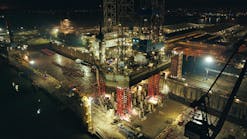PRAC maximizes research results through 'clusters of excellence'
Glen R. Gibling Petroleum Research Atlantic Canada
Academia, government, and industry are pooling their resources to increase pet-roleum related research in Atlantic Can- ada. Petroleum Research Atlantic Canada (PRAC) is one means to that end. PRAC's goal is to foster, fund, and facilitate petroleum-related interdisciplinary research and develop-ment (R&D) within Atlantic Canada and to diffuse that knowledge to the benefit of the region's economy. The not-for-profit, public-private partnership has already seen a number of successes.
Custers of excellence
One of the ways PRAC is reaching its objectives is through "clusters of excellence." Clusters are formed by researchers and industry representatives who come together to share ideas and expertise and develop solutions to challenges.
One cluster of excellence that has already seen some success was formed to examine vortex induced vibration (VIV).
The cluster of excellence in offshore safety has created a way to recreate a crisis environment to better prepare personnel for offshore emergencies.
null
Each of several researchers interested in the topic was looking for support for an individual area of expertise, but all were having difficulty obtaining funds. At PRAC's suggestion, the individuals formed a cluster of excellence comprising personnel from three universities, a federal research facility, and a private firm. The group brought modeling, computational fluid dynamics analysis, fatigue, and testing facilities expertise together to offer a complete research package that can design and test a model, develop simulation software, and analyze potential fatigue that a riser can be subjected to. Their joint research submissions are beginning to bear fruit.
The offshore safety cluster of excellence tells another success story.
Dr. Brian Veitch from Memorial University of Newfoundland, in cooperation with Dr. Antonio Simoes Re of Newfoundland's Institute for Ocean Technology, submitted a project proposal, "Offshore Evacuation Performance in Extreme Weather." The project involved model testing and evaluating and developing best practice guidelines for several lifeboat launching systems. They leveraged a $50,000 PRAC grant three-fold – but more importantly, the idea for a survival craft simulator evolved during discussions with industry.
At present, there is no way to prove personal competence during high stress emergency situations. It is too dangerous to practice lowering survival crafts in bad weather, and calm weather does not subject a worker to the stress levels experienced in an emergency. The simulator will fill that void.
The researchers met with the Centre for Marine Simulation and a specialist from Memorial University's human kinetics department, and formed a research team to develop a simulator. PRAC suggested the research team coordinate efforts with two researchers in Nova Scotia who were researching the design of survival suits and applying human factors analysis to determine ways to improve offshore platform muster (two integral parts of an overall offshore safety program) to ensure they had a thorough knowledge of the challenge.
A Class A type computer survival craft training simulator is nearing completion. It will be converted into a Class B type simulator by mounting it on a motion base. Finally, it will become a Class C type simulator that is able to place a trainee inside a vessel that matches every detail of the inside of a survival craft.
In the end, emergency conditions including sights, sounds, smell, and motion will be simulated. When the final product is ready for use, people responsible for lowering and controlling survival boats can be safely exposed to high-stress situations and prove their competence.
The cluster of excellence in offshore safety now boasts additional members, including Cathexes and Mad Rock (companies that have spun off from the university) and a company called SafetyNet. The group is developing initiatives that will aid in avoiding and mitigating hazards and creating inherent safety offshore.
Leveraging success
To date, PRAC has provided $1.7 million toward 36 projects. These projects leveraged an additional $7.1 million, resulting in $8.8 million of research over the past four years. "We view PRAC's money to be 'seed money' that is used to initiate research and stimulate interest in practical solutions to current challenges that are impeding the industry," Lee Shinkle, PRAC's executive director, said. PRAC encourages collaboration among researchers, research organizations, and industry. The organization also supports projects that have synergy in order to best capitalize on the individual contributors. "Our ultimate goal is to develop a number of clusters of excellence," Shinkle said.
"Sometimes it appears as though you need a lot of luck in order to make things work and advance. Without the initial PRAC seed funding we would have never gotten started," Memorial University's Dr. Veitch said. The initial objective of this project was to make things safer in the offshore, but the end result has exceeded expectations. Research results caused the cluster to move into commercialization, which in turn stimulated economic growth within the region. "Industry is now coming to us instead of us going to them," Veitch said. So far, we have booked over a million dollars of research and spun off one company and countless products.






